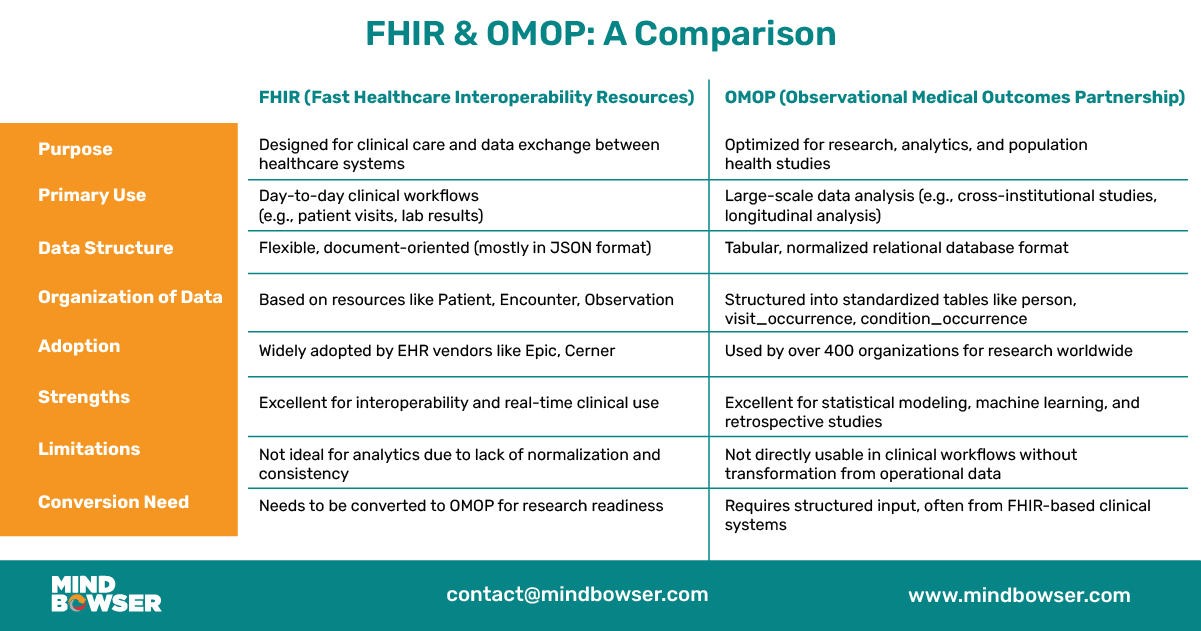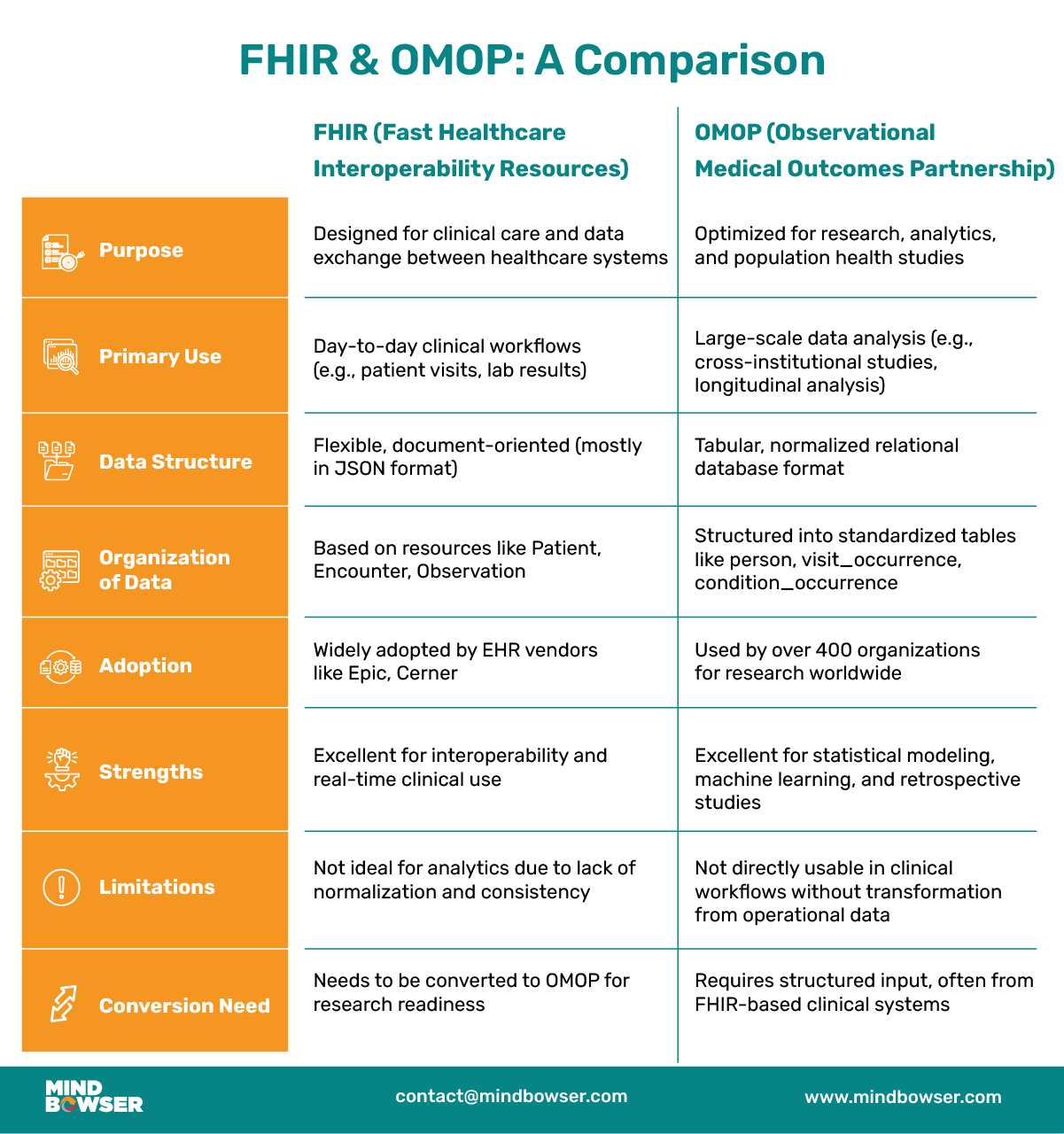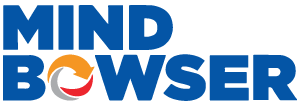Healthcare organizations today face a critical challenge: their Electronic Health Records (EHRs) store vast amounts of clinical data in formats optimized for patient care, but researchers need that same data structured for analytics and population health studies. This disconnect between operational systems and research requirements has created a significant barrier to advancing medical knowledge. FHIR to OMOP conversion has emerged as a practical solution to bridge this gap.
Fast Healthcare Interoperability Resources (FHIR) has emerged as the gold standard for healthcare data exchange. Epic, Cerner, and other major EHR vendors have adopted FHIR R4 as their primary API standard, enabling seamless data sharing between healthcare systems. FHIR’s resource-based approach organizes clinical data into intuitive concepts like Patient, Encounter, and Observation, making it perfect for clinical workflows.
However, FHIR’s strength in clinical operations becomes a limitation in research contexts. The flexible, document-oriented structure that serves clinicians well doesn’t translate easily to the tabular, normalized format that researchers need for statistical analysis and machine learning applications. This is where FHIR to OMOP conversion becomes essential.


The Observational Medical Outcomes Partnership (OMOP) Common Data Model addresses this research need by providing a standardized, analytics-optimized database schema. FHIR to OMOP transformation enables consistent table structures that support:
🔸 Cross-institutional research studies
🔸 Longitudinal patient analysis
🔸 Population health insights
🔸 Drug safety surveillance
🔸 Clinical quality measurement
The OMOP CDM has been adopted by over 400 organizations worldwide, creating a global network for collaborative healthcare research.
The challenge lies in converting FHIR’s flexible JSON documents into OMOP’s structured relational tables. Traditional approaches to FHIR to OMOP conversion have relied on custom ETL (Extract, Transform, Load) processes that are:
🔸 Time-intensive: 9–12 months to develop
🔸 Maintenance-heavy: Constant updates for new data fields
🔸 Error-prone: Manual mapping introduces inconsistencies
🔸 Expensive: $500K–2M typical implementation costs
A revolutionary approach leverages medical terminology standards to automate the FHIR to OMOP conversion process. Instead of hard-coding mappings, this method uses the inherent domain classification within medical codes to intelligently route data to appropriate OMOP tables.
🔸 Extract medical codes from FHIR resources (SNOMED, LOINC, RxNorm)
🔸 Lookup concept metadata in OMOP vocabularies
🔸 Use domain classification to determine target OMOP table
🔸 Generate multiple records from single FHIR resources as needed
For example, a single FHIR Encounter containing codes for a visit, diagnosis, and procedure automatically creates records in three separate OMOP tables: visit_occurrence, condition_occurrence, and procedure_occurrence.
Organizations implementing automated FHIR to OMOP conversion report:
🔸 90% reduction in manual ETL effort
🔸 3–4 week implementation vs. 9–12 month custom builds
🔸 Research-ready data available within hours
🔸 200% ROI in the first year
As healthcare continues its digital transformation, the ability to rapidly convert operational data into research-ready formats becomes a competitive advantage. FHIR to OMOP automation helps organizations lead in:
🔸 Evidence-based care delivery
🔸 Population health management
🔸 Clinical research acceleration
🔸 Value-based care optimization
The convergence of FHIR and OMOP, enabled by intelligent automation, represents the future of healthcare analytics—where clinical care and research excellence work hand in hand to improve patient outcomes.
Healthcare providers store vast amounts of clinical data in EHRs using formats like FHIR, which are great for patient care but not ideal for research. Researchers require structured, normalized data—typically in the OMOP format—for effective analysis and study.
FHIR (Fast Healthcare Interoperability Resources) is a standard for exchanging healthcare data electronically. It’s widely adopted by EHR vendors like Epic and Cerner and structures data around concepts like Patient, Encounter, and Observation, making it well-suited for clinical workflows.
FHIR is document-based and highly flexible, which benefits clinical use but complicates analytical tasks. Researchers need structured, tabular formats—something FHIR doesn’t inherently provide.
OMOP (Observational Medical Outcomes Partnership) is a Common Data Model designed to support healthcare research by transforming diverse clinical data into a standardized, analytics-friendly format. Unlike FHIR, which is optimized for clinical workflows, OMOP structures data into relational tables that enable powerful statistical analysis and machine learning. This makes it ideal for conducting cross-institutional research, tracking patients over time, analyzing population health trends, monitoring drug safety, and measuring clinical quality. With adoption by over 400 organizations worldwide, OMOP facilitates large-scale, collaborative studies that drive evidence-based healthcare improvements.

We worked with Mindbowser on a design sprint, and their team did an awesome job. They really helped us shape the look and feel of our web app and gave us a clean, thoughtful design that our build team could...


The team at Mindbowser was highly professional, patient, and collaborative throughout our engagement. They struck the right balance between offering guidance and taking direction, which made the development process smooth. Although our project wasn’t related to healthcare, we clearly benefited...

Founder, Texas Ranch Security

Mindbowser played a crucial role in helping us bring everything together into a unified, cohesive product. Their commitment to industry-standard coding practices made an enormous difference, allowing developers to seamlessly transition in and out of the project without any confusion....

CEO, MarketsAI

I'm thrilled to be partnering with Mindbowser on our journey with TravelRite. The collaboration has been exceptional, and I’m truly grateful for the dedication and expertise the team has brought to the development process. Their commitment to our mission is...

Founder & CEO, TravelRite

The Mindbowser team's professionalism consistently impressed me. Their commitment to quality shone through in every aspect of the project. They truly went the extra mile, ensuring they understood our needs perfectly and were always willing to invest the time to...

CTO, New Day Therapeutics

I collaborated with Mindbowser for several years on a complex SaaS platform project. They took over a partially completed project and successfully transformed it into a fully functional and robust platform. Throughout the entire process, the quality of their work...

President, E.B. Carlson

Mindbowser and team are professional, talented and very responsive. They got us through a challenging situation with our IOT product successfully. They will be our go to dev team going forward.

Founder, Cascada

Amazing team to work with. Very responsive and very skilled in both front and backend engineering. Looking forward to our next project together.

Co-Founder, Emerge

The team is great to work with. Very professional, on task, and efficient.

Founder, PeriopMD

I can not express enough how pleased we are with the whole team. From the first call and meeting, they took our vision and ran with it. Communication was easy and everyone was flexible to our schedule. I’m excited to...

Founder, Seeke

We had very close go live timeline and Mindbowser team got us live a month before.

CEO, BuyNow WorldWide

Mindbowser brought in a team of skilled developers who were easy to work with and deeply committed to the project. If you're looking for reliable, high-quality development support, I’d absolutely recommend them.

Founder, Teach Reach

Mindbowser built both iOS and Android apps for Mindworks, that have stood the test of time. 5 years later they still function quite beautifully. Their team always met their objectives and I'm very happy with the end result. Thank you!

Founder, Mindworks

Mindbowser has delivered a much better quality product than our previous tech vendors. Our product is stable and passed Well Architected Framework Review from AWS.

CEO, PurpleAnt

I am happy to share that we got USD 10k in cloud credits courtesy of our friends at Mindbowser. Thank you Pravin and Ayush, this means a lot to us.

CTO, Shortlist

Mindbowser is one of the reasons that our app is successful. These guys have been a great team.

Founder & CEO, MangoMirror

Kudos for all your hard work and diligence on the Telehealth platform project. You made it possible.

CEO, ThriveHealth

Mindbowser helped us build an awesome iOS app to bring balance to people’s lives.

CEO, SMILINGMIND

They were a very responsive team! Extremely easy to communicate and work with!

Founder & CEO, TotTech

We’ve had very little-to-no hiccups at all—it’s been a really pleasurable experience.

Co-Founder, TEAM8s

Mindbowser was very helpful with explaining the development process and started quickly on the project.

Executive Director of Product Development, Innovation Lab

The greatest benefit we got from Mindbowser is the expertise. Their team has developed apps in all different industries with all types of social proofs.

Co-Founder, Vesica

Mindbowser is professional, efficient and thorough.

Consultant, XPRIZE

Very committed, they create beautiful apps and are very benevolent. They have brilliant Ideas.

Founder, S.T.A.R.S of Wellness

Mindbowser was great; they listened to us a lot and helped us hone in on the actual idea of the app. They had put together fantastic wireframes for us.

Co-Founder, Flat Earth

Mindbowser was incredibly responsive and understood exactly what I needed. They matched me with the perfect team member who not only grasped my vision but executed it flawlessly. The entire experience felt collaborative, efficient, and truly aligned with my goals.

Founder, Child Life On Call

The team from Mindbowser stayed on task, asked the right questions, and completed the required tasks in a timely fashion! Strong work team!

CEO, SDOH2Health LLC

Mindbowser was easy to work with and hit the ground running, immediately feeling like part of our team.

CEO, Stealth Startup

Mindbowser was an excellent partner in developing my fitness app. They were patient, attentive, & understood my business needs. The end product exceeded my expectations. Thrilled to share it globally.

Owner, Phalanx

Mindbowser's expertise in tech, process & mobile development made them our choice for our app. The team was dedicated to the process & delivered high-quality features on time. They also gave valuable industry advice. Highly recommend them for app development...

Co-Founder, Fox&Fork
